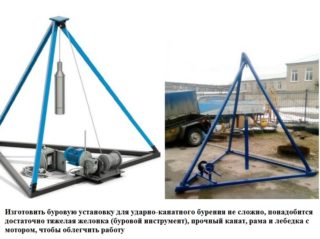Without a water well or a well, it is impossible to organize an independent water supply in a private house or in a summer cottage. When creating borehole shafts, different drilling tools are used. It can be a portable device or a small drilling rig. In the presence of suitable materials, the simplest drilling equipment can actually be made by hand.
The purpose of the drilling apparatus
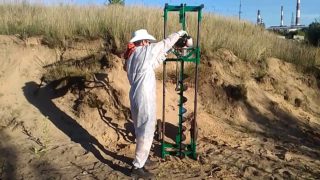
DIY devices or mini-installations are used to create:
- small diameter holes;
- exploration mines, through which they receive information about the state of soils, aquifers;
- shallow water wells.
To achieve these goals, mobile or hand-held devices are sufficient. To create artesian mines, other technologies are used - complex in design and powerful self-propelled drilling mechanisms, usually based on KamAZ. Due to its size, a large area is required for operation. But the depth of the wells, which are obtained with the use of such devices, fully compensates for the problems with the volume of the occupied space.
Types, principle of operation and device
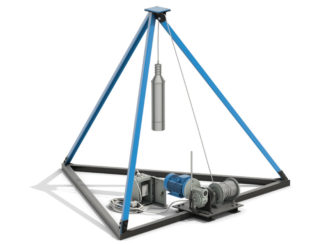
Portable drilling units are easy to transport and use in a confined space, and their repair and operation does not require special knowledge. Most of the devices are non-volatile, which allows work in the field or in an unprepared area. The cost per running meter of the barrel is low.
All devices for creating shallow wells are divided into three types: percussion, screw and rotary. Each variety has its own characteristics.
Impact devices
They are triangular frame structures on a solid foundation. A flexible cable with a bailer and a chisel is attached to it. The devices are easy to install and reliable in operation, have an increased working life. With their help, a large number of wells can be drilled.
The principle of operation is to use a shock projectile, which falls down under its mass and crushes the soil.
The tubular striking element up to 2 meters long has a sharpened bottom edge for convenience. To extract the crushed soil, use a thief. A valve device is installed in the pipe, which holds the loose soil when rising to the surface.
First, a small hole is made with a hand drill, then drilling is started using the rig. After 2-3 working cycles, the well will be ready. The rate of drilling of mines with such a unit is small; special casing with large-diameter pipes will also be required, as a result of which the price of the well rises.
Rotary structures
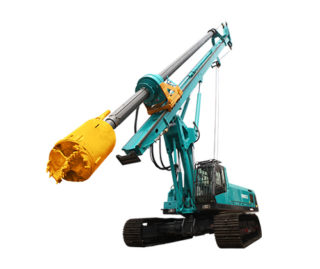
Machines of this type have significant productivity and allow you to quickly punch high-quality wells in any soil, even if there are layers of limestone. Structurally, the device consists of a vertical pipe and a rock cutting knife. In the process of its work, a water stream is supplied to the surface under pressure, which helps to soften the earth, and it becomes more pliable. Water is also required to clear soil from the mine shaft.
This operation can be performed in two ways:
- Water is supplied through the rod, and the removal of dirt is carried out through the shaft of the well itself.
- The well is filled with water, and mud is removed by means of special equipment and pumps.
The latter method is suitable for punching a mine to a depth of 55 meters.
Auger aggregates
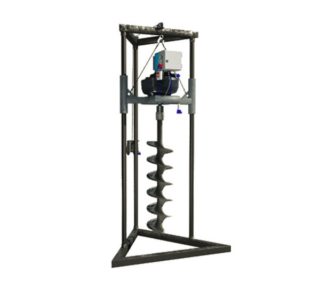
Equipped with a drill auger for earth extraction. When using them, additional flushing of the hydraulic structure with water is not required. The length of the drill rod together with the auger reaches two meters. If it becomes necessary to increase it, the rod element is increased by adding an extension insert by means of a threaded connection.
Drilling is carried out both manually and automatically. After 2-3 turns, they take out the barbell, and clean the loosened earth from it.
For deep penetration, electromechanical devices that have a drive should be preferred. It will provide lift and transfer torque to the auger top.
The downside to using such a unit is the need to systematically remove the rod to clear the ground. The method excludes carrying out work on soils with increased hardness or loose rocks. Typically, screw aggregates are used to pierce wells up to 80 m deep.
Flush drilling equipment
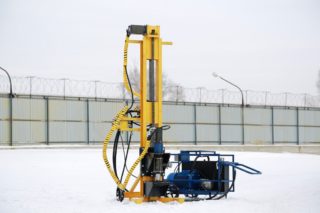
The greatest efficiency is achieved when drilling mines with systematic flushing with drilling fluid. It brings all the crushed soil to the surface. For this, equipment is used, which consists of the following elements:
- drill rods with a drill, allowing crushing the earth;
- a drive mechanism that provides translational movement and rotates the working part;
- pump with pressure hoses supplying water;
- transition unit - a swivel that transmits a torque to the tool.
Such a unit is used if it is required to pierce a fairly deep well. Taking into account the composition of the earth, the drilling speed can be up to 10 m / s.
Shaft washing is carried out in a direct way. The solution flows through the rod, and, washing away all the loosened earth, lifts it up the shaft. Backwashing involves feeding fluid down the wellbore and removing it through the boom.
Small Drilling Rig
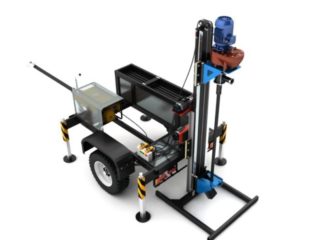
MGBU is designed for work in those areas where it is impossible to bring an overall drilling rig, and simple portable devices are not powerful enough.
Small-sized water well drilling rigs are multifunctional and versatile. They are equipped with an electric motor, and the presence of electromagnetic starters that distribute and control energy between the motor and the connected circuits ensures uninterrupted operation.
The device also contains the following mechanisms:
- waterproof control panel, which is important when creating water-bearing wells;
- drill - the main element for crushing the soil, reinforced and ordinary, depending on the type of land;
- a support unit responsible for fastening the rotator;
- a casing table used to sink and retrieve the drill pipe;
- a backing fork and a wrench required for unscrewing and subsequent fastening of the column parts;
- conical locks for connecting column elements;
- side struts for stability of the MGBU.
The device is also equipped with a trolley with an adjustable distance, which is used for fastening. In addition, it can withstand various load directions by means of rollers. A winch is used to lift the mechanism vertically. Its material and density are selected depending on the mass to be lifted.
Small-sized drilling units make it possible to create rather deep wells - up to 100 m, and sometimes even more. They are small in size and mobility, so they can be easily transported, for example, in a car trailer.They are used in relief areas with complex access roads. Prices for such equipment for drilling water wells start at 130,000 rubles.
Features of assembly and operation
- connecting plumbing cross fitting;
- hacksaw for metal work;
- steel pipe and squeegee with a cross section of 0.5 inches;
- steel plates;
- adjustable wrench.
The installation of the unit implies the preparation of a pipe section, which will later be used as a base for the drilling apparatus.
The assembly process goes in the following sequence:
- To create a cross structure, notch the pipe ends to a depth of two centimeters.
- Weld steel plates as a tip from the end of the pipe segment.
- Connect the water supply hose to the cross hole. For a secure fit, use an adapter.
- Check the performance of the structure by supplying water.
- Install plumbing threads in the cross hole - made of polymers or hemp.
- Connect the pipe section to which the tip is installed to the base by means of a squeegee.
After the end of the punching of the shaft and when deepening by a meter, the tip is rearranged to a longer pipe section.
A manual device will be an excellent solution for punching a well in soft, peaty and clayey soils with a depth of the water layer in the area not more than 20 meters. Such devices are buried much less than MGBU, but their compact size allows you to drill shaft holes in inconvenient places on the site, for example, next to the walls of buildings or fences.
You can also create a home-made device based on a walk-behind tractor, equipped with a mechanical drive, which is set in rotation by a motor-drill motor.
The compact dimensions of such installations allow one person to carry out the work, and the use of a reduction gearbox allows drilling shafts of significant diameter.
The choice of drilling equipment is determined by the design of the well, the drilling method, the required parameters of the tool used, as well as the requirements for the transportability of the drilling rig. If in doubt, it is better to use the services of professionals.

